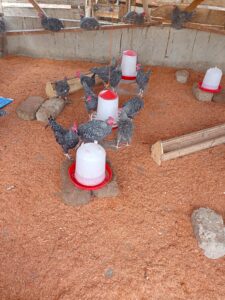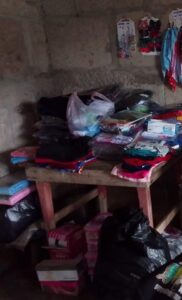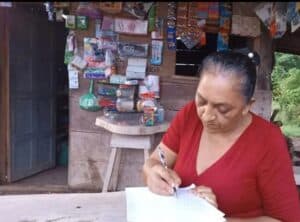
Program Officer, Rodolfo, Follows Up With Farmers Who Planted Biofortified Beans
By Rodolfo Ricardo Hernandez Navas – Agriculture Program Officer

Family crop of beans.
The biofortified bean varieties, INTA-Nutritivo and Rendidor, were evaluated in various regions and climates of Nicaragua by the Nicaraguan Institute of Agricultural Technology (INTA). These beans contain higher contents of iron (86 ppm) and zinc (43 ppm) than traditional bean varieties which only have 50 ppm of iron and 28 ppm of zinc. It is a seed variety that adapts to humid tropical climates, and its bushiness and short height make it ideal for Self-Help’s double-row planting technique.
Because Self-Help promotes crops with high nutritional value, Self-Help decided to start promoting biofortified bean varieties with 30 farmers and their families. All of the farmers are members of the San Marcos and San Lucas de Los Chiles RL Cooperative because they have extensive experience in bean cultivation. Each family received 15 pounds of seeds for the establishment of plots that are 1,320 m2.
In March 2020, Agriculture Program Officer, Rodolfo Ricardo Hernández Navas, met with a group of 10 farmers who came to the cooperative to return the 30 pounds of INTA-Nutritivo and Rendidor bean seed, and Rodolfo spoke with them about their experiences. They talked about the quality of the seed, which is excellent, although some farmers have not finished harvesting their beans completely because of the heavy rains.
A farmer named Santana from the La Rampla community harvested 100 pounds of beans. The harvest was lower than expected due to the high incidence of Meterworm (Trichoplusia ni) pests and heavy rains in the first days post-planting. Santana said he did not use any fertilizers or chemicals. He also said that if he had not used the new biofortified bean seed, he would not have harvested anything.
Of Santana’s 100-pound harvest, he repaid Self-Help with 30 pounds of beans. The rest of his harvest will be used as seed for the next cycle in October 2020.

Bean field.
Another farmer named Serafín from the community of Los Pavones N ° 2 planted 15 pounds of beans with the same double-row planting technique used on the Quality Protein Maize (QPM) crops; however, the distance between the rows was greater than Self-Help’s agriculture team typically recommends. He applied commercial chemical fertilizers and employed good agronomic practices. However, during cultivation there were attacks by pests such as the Meterworm (Trichoplusia ni) and excessive rain as winter ended.
Serafin and his family harvested 450 pounds of beans.
“My yield would have been higher, but that worm plague attacked my crops,” Serafin said. “During the next harvest, I will be better prepared to combat the worms.”
“I am going to save 100 pounds for seed for the next harvest and 100 pounds for my family’s consumption,” Serafin said. “The rest of the 250 pounds I am going to sell in my community.”
Silverio, another farmer from the Melchora community No. 2, obtained a yield of 200 pounds. However, he did not use commercial chemical fertilizers, only organic fertilizer in foliar form (Phosphite-Frix PK). He did not do any weed or pest control.
“I didn’t manage the beans well, but those beans are good. The land didn’t help, because it was full of weeds and bush. The bush was too big when I finally decided to apply a herbicide,” Silverio said. “Despite all of that, I still yielded 200 pounds. This bean is good because it is bulky and bushy. If it had been the normal Creole bean, I wouldn’t have harvested anything at all.”
Silverio is planning to save about 50 pounds to sow in November. His family has already experimented with using the beans in soup. The taste of beans in cooking is critical to rural farming families accepting a new bean variety into their diets. They liked the beans, and the family decided that the remaining 120 pounds will be consumed at home instead of selling it like they normally do with surplus crops.

Isidro holding bushels.
Coop leader, Isidro, is from the San Agustín community. He harvested 300 pounds from his initial 10 pounds of seed (he gave the other 5 pounds of seed to his neighbor, who ultimately didn’t plant it because it was too late in the season). Due to the heavy rains, Isidro’s batch of beans failed because of flooding and rotted seed. Isidro applied a 20-pound mixture of fertilizer 15-15-15 + Ammonium Sulfate + Potassium Muriate 0-0-60, as well as organic fertilizer Phosphite-Frix PK, in the form Foliar. This product is an inducer and fixer of bean flowers and has fungicidal properties and provides good results. Isidro would have obtained a harvest similar to Serafín’s if there hadn’t been heavy rains.
“The quality of the beans and the soup is very good even though red bean varieties are normally disliked for their taste and how thick they make the soups,” Isidro said. “This nutritious variety surprised me because it is very good, soft, and it cooks quickly. My whole family liked it.”
Isidro will sow 150 pounds in November and will save 100 pounds to consume with his family.

 Previous Post
Previous Post Next Post
Next Post


